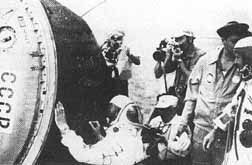
21 July - Farewell
Leonov and Kubasov had signed off the air shortly after 1:37 (9:37 in Moscow) on the afternoon of the 20th, after stowing all of the returnable items in the descent module. Following a rest period of nearly 10 hours, the Soyuz crewmen advised the ground that they were awake and that all systems were normal. After exchanging flight data and receiving a weather report, they ate breakfast and donned their space suits. Their pressure integrity check, conducted at about 3:30 a.m. indicated that their suits were functioning normally. Leonov and Kubasov ran through their re-entry checklist. Moscow Mission Control gave the following announcement:
The Mission Control Center's calculated the descent-orbit data. This data has been entered into the program computer . . . the crew is monitoring the orientation and also the transmission of information. The deorbit data . . . is the following . . . the braking pulse to shift the spacecraft from Earth to a...
[345]
 |
At left, ASTP Cosmonauts Leonov and Kubasov (speaking) are interviewed by Soviet newsmen shortly after their safe landing in Kazakhstan. Below, Kubasov autographs the side of the Soyuz descent vehicle (Soviet Academy of Sciences photos). |
|
|
...descent trajectory will be 120 meters per second. This braking pulse . . . will operate for 194.9 seconds at the altitude of 214 kilometers and 13 hours and 9 minutes.47
Throughout the Soviet Union, crowds gathered in homes and in stores with televisions to watch the rare treat of a live broadcast of a Soyuz recovery. At Houston, a few hardy souls, in addition to the ground control team, were up to witness this early morning event.
The deorbit burn came exactly on time (5:09 in Houston), and the Soyuz crew notified Moscow that the retro-engine had fired for the calculated period and had been turned off at 5:13:38. Separation of the orbital and descent modules came 9 minutes later. Leonov advised the ground that the gravitational forces had built up, passed, and were less than he had anticipated. A task force of Soviet helicopters and ground-based personnel moved into the landing area. All in all, this formidable armada of trucks and aircraft was about equal in number to the size of the sea-based team that would later greet Apollo.
Soviet air rescue pilots began receiving radio signals from the spacecraft at approximately 5:40, and almost simultaneously helicopter-borne television cameras began transmitting pictures of the descent. As Soyuz floated downward, Walter Cronkite, in search of commentary on the event, noted for his viewers that the color quality of the pictures was not very good. But good or bad, they were extraordinary! Within a few feet of the ground, the automatically fired landing rockets slowed the "thumpdown" of the descent vehicle. A cloud of dust caused by the braking rockets of Soyuz engulfed the craft and caused momentary anxiety for those viewers who did not understand its meaning. Three minutes after landing, at 5:51, a slightly shaky Kubasov was the first to exit. Leonov and his flight engineer smiled broadly and waved to photographers on the scene. Houston Mission Control reported: "We're just looking at the TV here and see that Soyuz has landed safely, and Alexey and Valeriy were outside of the spacecraft and seem to be in good health."48 Stafford asked Houston to give the Soviets their best and to say that he was glad to hear that everything went well. For the remaining three and a half days, Stafford, Slayton, and Brand would concentrate on their experiments, but in many respects the saga of Apollo and Soyuz had come to an end.
47. ASTP mission commentary transcript, SR 156/1 and SR 159/1-2, 20 July 1975, and SR 171/2, 21 July 1975; "2 Cosmonauts, Soyuz Spacecraft Back in the USSR," Washington Star, 21 July 1975; Robert C. Toth, "Soyuz Touches Down Perfectly in Soviet Desert," Los Angeles Times, 22 July 1975; Hal Piper, "Soyuz Ends Its Half of Joint Flight," Baltimore Sun, 22 July 1975; and "Crowds Flock to Watch Rare Public Landing," Washington Post, 22 July 1975.
48. Program Operations
Office, "ASTP Technical Air-to-Ground Voice Transcription," p. 679.
Next
